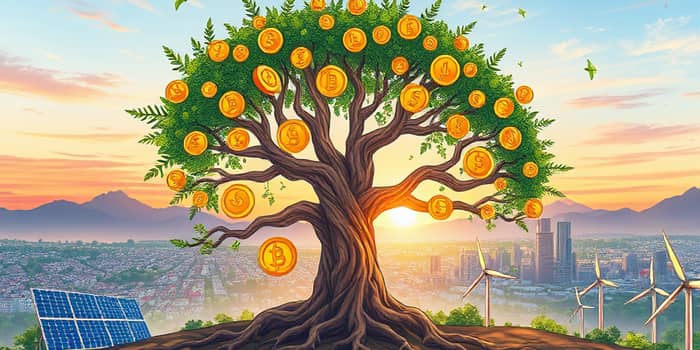In 2025, navigating economic volatility and technological disruption demands a fresh approach to capital growth. Investors and businesses must blend innovation with responsibility, ensuring money works harder and greener.
From renewable energy to AI-driven funds, sustained high-return growth potential lies within reach for those who allocate wisely and adapt quickly.
The Macro Backdrop: Volatility, Technology, and Sustainability
Economic and geopolitical uncertainties continue to influence market dynamics. With interest rates remaining low, capital is flowing into diverse asset classes, especially those offering resilience against shocks and a path to sector-spanning portfolios balancing risk and reward.
Policy incentives such as the Inflation Reduction Act and the EU Green Deal are catalyzing renewables, while global supply chain shifts and digital transformation intensify demand for smart financing solutions.
High-ROI Sectors and Strategic Allocation
Identifying where capital can deliver the highest returns is critical. Company leaders now favor diversified strategies that blend innovation, sustainability, and reliable income streams.
Institutional investors are increasingly deploying capital into durable cash-flowing assets with strong tenants, from commercial real estate leases to thematic bonds tied to climate goals.
Sustainability and ESG Integration
Environmental, Social, and Governance (ESG) criteria have moved from niche to mainstream. In 2024, the sustainable finance market reached $8.2 trillion, up 17% from the previous year.
- 73% of US investors expect sustainable investments to grow significantly by 2025.
- 81% of firms integrate ESG into core decision-making processes.
- AI-driven analytics are used by 65% of sustainable investment executives.
Regulatory trends are tightening in Europe while the US faces political pushback, underscoring the need for transparent impact measurement and reporting. Private assets and thematic bonds tied to biodiversity, climate resilience, and the UN SDGs are capturing growing inflows.
Innovation, AI, and Smart Financing
Technology underpins the next frontier of capital growth. Companies leverage predictive analytics for strategic capital deployment, enabling swift, data-backed decisions.
Flexible financing models—such as structured payments, leasing arrangements, and milestone-based funding—allow rapid deployment of AI, cybersecurity, and automation without large upfront costs.
Portfolio Construction: Diversification and Resilience
Building a robust portfolio means balancing high-growth opportunities with defensive positions. A typical approach might include:
- Renewables for growth and policy-driven yields.
- Dividend growth stocks for stability and compounding.
- Tech and healthcare for innovation-led outperformance.
- Bonds or real assets to cushion volatility.
This simple yet resilient allocation mix has attracted institutional capital seeking predictable cash flows alongside upside potential.
Capital Raising and Efficient Deployment
Raising fresh capital requires targeted, data-driven marketing and deep regulatory expertise. Educating investors on thematic trends—from green energy to AI—builds trust and unlocks larger commitments.
Deploying capital effectively means aligning funding structures with project milestones, reducing risk and reinforcing confidence. Many firms now adopt tax-loss harvesting and thematic investing strategies to optimize after-tax returns.
Challenges, Risks, and Emerging Opportunities
While prospects are bright, prudent risk management remains vital. Key considerations include:
- Political and regulatory shifts that can alter ESG incentives.
- Greenwashing concerns demanding robust due diligence.
- Supply chain and geopolitical disruptions.
Proactive measures like proactive scenario planning and supply chain diversification help cushion portfolios against sudden changes. Transition investing—engaging with carbon-intensive industries on their decarbonization journey—opens meaningful impact opportunities and financial returns.
Conclusion: Winning with Smart, Sustainable Capital Growth
In 2025, achieving sustained capital growth with positive impact requires a balanced fusion of innovation, sustainability, and disciplined allocation. By focusing on high-ROI sectors, integrating ESG rigorously, and leveraging advanced financing models, investors can cultivate a future where green and growth go hand in hand.
Embrace these strategies, stay informed on evolving regulations, and commit to transparency. Growing your green responsibly is not just an art—it’s the path to lasting prosperity.
References
- https://www.ibisworld.com/blog/strategic-capital-allocation/99/1126/
- https://connect.sustainalytics.com/six-sustainable-investing-trends-to-watch-in-2025-report
- https://www.fundz.net/venture-capital-blog/5-proven-investment-strategies-for-2025-from-self-made-millionaires
- https://www.ussif.org/research/trends-reports/us-sustainable-investing-trends-2024-2025-executive-summary
- https://sentinelnetlease.com/featured/smart-capital-cre-2025/
- https://www.rothschildandco.com/en/newsroom/insights/2025/06/wm-business-with-humanity-esg-insights-for-2025-and-beyond/
- https://news.tdsynnex.com/featured/financing-innovation-how-smart-capital-strategies-drive-growth-in-ai-and-security-technology/
- https://www.schroders.com/en-us/us/individual/insights/2025-sustainable-investment-outlook-top-8-trends-for-north-america-in-the-year-ahead/
- https://www.confluentam.com/the-ultimate-guide-to-smart-investing-in-2025/
- https://www.morganstanley.com/insights/articles/sustainable-investing-interest-2025
- https://www.defianceanalytics.com/blog/effective-capital-raising-marketing-strategies-for-success-in-2025
- https://www.generationim.com/our-thinking/sustainability-trends/the-sustainability-trends-report-2025/
- https://www.morganstanley.com/im/en-us/individual-investor/insights/articles/smart-and-simple-investing-for-2025.html
- https://www.cfainstitute.org/insights/articles/sustainable-investing-trends
- https://www.ideafinancial.com/blog/smart-financing-strategies-for-business-growth-in-2025
- https://ieefa.org/resources/sustainable-investing-outlook-strong-returns-amid-net-flow-pressures










